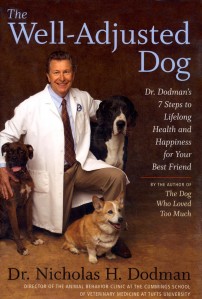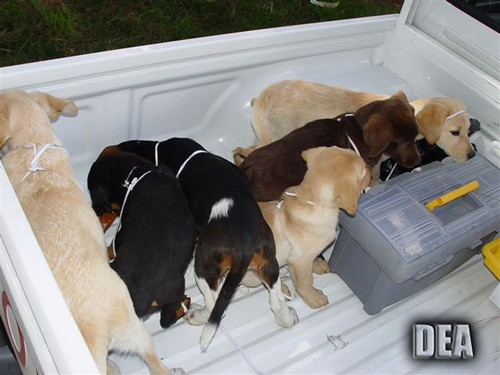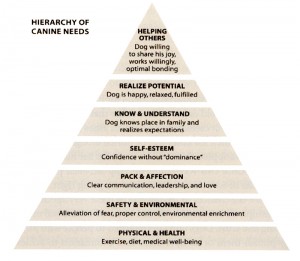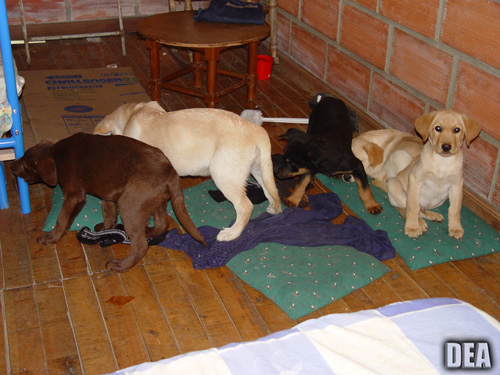Best, Short Dog Book Ever – Nicholas Dodman’s “The Well-Adjusted Dog”
March 17, 2009
 Dr. Nicholas Dodman, Director of the Animal Behavior Clinic at the Cumming School of Veterinary Medicine at Tufts University has produced a small gem of a book, The Well-Adjusted Dog.
Dr. Nicholas Dodman, Director of the Animal Behavior Clinic at the Cumming School of Veterinary Medicine at Tufts University has produced a small gem of a book, The Well-Adjusted Dog.
There’s more good, solid information in its 250 pages than in a whole host of other books written by dog ‘experts’ who have little or no credentials in the science and study of canines (Cesar Milan, I’m looking at you).
“Your job as a dog owner,” Dodman writes “is to try and understand your dog’s life fro his point of view, and to lead and protect, not to dominate, punish, and force a dog into submission, as popularized on too many of today’s TV shows.”
When this book comes out in paperback, I can see giving out multiple copies to neighbors and fellow dog owners, rather than trying to answer their questions myself.
One of the first and most vital points he makes is his belief that most dogs are under-exercised and bored out of their minds. (From my own experience I think this analysis is on the money). This leads to a multitude of behavioral problems including barking, inappropriate chewing, aggression, tail chasing, licking to the point of skin damage and more.
The average dog needs a minimum 30 minutes of aerobic exercise a day, every day. How many dogs do you know that meet that requirement?
Given that behavioral problems are the primary reason dogs are surrendered to shelters (the majority of whom are fated for euthanasia/destruction) proper handling of these issues may be essential to save the life of someone’s pet.
What I especially appreciate is his easy prose style and the clarity of his thinking even in controversial areas like herbal treatments and nutraceuticals. Here’s a sample of his writing about alternative medicine for dogs:
“Homeopathy—wherefore art thou, homeopathy? Though it’s popular in Europe, I have serious concerns about this branch of alternative medicine. The theory, of course, is that a little does of what ails you does you good. I can see how the concept applies to vaccination and desensitization to allergens, because inoculates stimulate an immune response—but I can’t see how it applies in other situations. Various homeopathic behavioral remedies containing microscopic concentrations of herbal products are now on the market.”
“One such remedy — anti-anxiety drops— was originally developed by an Irish veterinary practitioner who whipped up a dilute concoction of herbs to treat mastitis (inflammation of the udder) in cows. Being a large-animal vet, cows and mastitis were dear to his heart. In a moment of brilliance, he decided to bottle the cattle remedy for use in dogs to treat what else but . . .anxiety. And thus anti-anxiety drops were created. Whether the product actually works is doubtful, but bottles of the stuff are flying off the shelves. Naturopaths are positively swarming for it. Testing of this product presumably went like this:
- Take a worried-looking, baking dog and film him.
- Put the anxiety drops on his tongue.
- Wait until he has calmed down.
- Film him again.
- He’s calm.
- It’s a miracle!
The point they seemed to miss is that the only mental state that can follow a disturbed one is calm. It’s just a matter of time. I sent a sample of the anti-anxiety drops to the Department of Biochemistry and Experimental Therapeutics at Tufts medical school to see whether I ws missing something about the ingredients. The reply came back, ‘Nick, there’s virtually nothing here. It’s water.’ I guess that’s the point.”
Dodman also has constructed a pyramid Hierarchy of Canine Needs (adapted from psychologist Abraham Maslow’s triangle of human needs) that neatly summarizes what you as a caring dog owner should be striving towards. See how close you are coming to these goals with your own dog. Click image for larger size.
The bottom line: Buy This Book!
Dogs of War – 1,000 Feral Dogs in Baghdad
January 5, 2009
In Islamic culture there is no history of keeping dogs as pets, they are considered unclean animals. The idea of having a pet dog, as opposed to a working dog, is seen as a recent, Western notion and is embraced by very few. There are no dog shelters or rescue groups in Iraq. When the population goes hungry, the dogs starve.
Now there is the problem of the feral dogs, seen as disease carriers and a direct danger to children and the elderly. In Baghdad 13 people died in August 2008 in the capital after being attacked by dogs and the only controversy is over how to eliminate them. Currently, rifles (above) and poisoned meat are the preferred methods.
(Source.)
Dogs as Livestock in South Korea
April 3, 2008
The Australian Herald Sun is reporting that the Seoul city government is trying again to classify dogs as livestock in a bid to legalize, license, and regulate the industry and raise health standards for consumers.
Estimates of somewhere between 2 and 4 million dogs are eaten in South Korea each year; in Seoul alone there are about 500 dog meat restaurants. Other estimates say that nationwide there are 6,000 restaurants serving dogs and they are enjoyed by 10% of the population. Since there is no current regulation the market is underground. Almost all of these dogs are slaughtered and processed in less than pristine, sanitary conditions, making dog meat a somewhat risky entree for diners.
If this proposal is made law and effectively enforced, it could produce a rise in consumption as restaurant goers grew more confident that the dog meat they were ordering is ‘safe,’ that is, free of pathogens and other contaminants.
There is local opposition. Lee Won-Bok, president of the Korea Association for Animal Protection said, “It’s horrible to imagine dog meat on display next to beef and ham at supermarkets. It would also be nauseating to see roasted dog meat on the menu of your restaurant.”
However, Won-Bok’s statement seems to ignore the fact that dog meat is already consumed in fairly large quantities nation wide and is currently on many restaurant menus. Keeping this industry underground invites abusive and inhumane treatment.
The ethics here seems quite clear: if you are going to serve dog meat, consumers should be protected by making sure that meat is processed under sanitary conditions.
I wonder what the status of bestiality laws are in South Korea? Is it illegal to have sex with dogs but OK to roast and eat them?
Research science tells us that dogs and pigs rank very close to each other on scales of intelligence and gentleness. If you arrived from another planet and observed conditions in a factory farm that raises and slaughters pigs and then saw how some people are practicing Yoga with their companion dogs, you would be quite appropriately confused.
The distinction drawn here is simply cultural and not based on biology.
As a consumer of pork and a platonic, non-sexual lover of dogs, I recognize the weakness of any moral outrage I might muster over this dichotomy. No one likes to accept the fact that their moral position is arbitrary and based on locale and not any set of hard facts.
But to pretend otherwise is a lie.
Heroin Puppies
February 2, 2008
Heroin Traffickers Used Puppies to Smuggle Drugs Medellin-based Organization Surgically Implanted Packets of Heroin in Pure-Bred Dogs
Feb. 3, 2006: The DEA arrested 22 heroin traffickers based out of Medellin, Colombia, who used puppies to smuggle drugs. The drug traffickers surgically implanted packets of liquid heroin into purebred dogs. All of the puppies who survived were adopted by local families and are still doing well today.
DEA has received numerous calls concerning the fate of the puppies who survived the horrific deeds of drug smugglers. Many of the callers expressed interest in adopting the dogs. We are pleased to report that all of the puppies have been taken in by Columbian families and are in great health. The public reaction to this story has been overwhelming. We thank you all for your interest.
— from the DEA’s website





